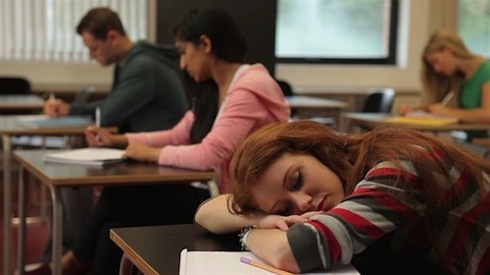Two of your waking hours would be well-spent with National Geo's Sleepless in America
11/25/14 03:08 PM

Catching up in the classroom after another night of too little sleep. National Geo photo
By ED BARK
@unclebarkycom on Twitter
Here’s an eye opener. “Americans sleep roughly two hours less per night than they did 50 years ago.”
Yes, those were the days -- without the Internet, smart phones, hundreds upon hundreds of TV channels or even Fantasy Football. Perhaps the country was just bored.
This is a serious topic, though. And National Geographic Channel’s new Sleepless in America certainly treats it as such. Premiering Sunday, Nov. 30th at 7 p.m. (central), it’s a well-produced, expert-drenched, statistics-slathered look at the myriad dangers of not getting enough rest.
Soothing lullabies need not apply. National Geo wants you to stay fully awake throughout this two-hour special. So the theme music tends to be “urgent” and constant in hopes of jolting viewers into an awareness of how big a problem is besetting us.
The above opening statistic is among many sprinkled amid the program’s talking heads, colorful imagery and chapters on how sleep deprivation can lead to obesity, diabetes, mental illness, temper tantrums, a faster growth of cancer cells and fatalities when drivers nod off at the wheel. Sleepless in America is bookended by the story of a man who lost his wife and two of the family’s four children when a dozing motorist veered across four lanes of traffic and hit them head-on in 2007.
The offending driver had just worked a double shift at a medical facility and was en route to having engagement photos taken with his fiancee. “It’s a story of loss on both sides,” says Ben S. Howard, who wasn’t in the car at the time. His surviving son and daughter both suffered serious injuries that required long recovery periods.
Sleepless in America is produced in partnership with the National Institutes of Health and the Public Good Projects. Its tone can be a bit preachy at times, but the problem itself is a clear and ever-present danger.
The populace increasingly is “so overwhelmed with all this stimulation,” says Dr. David Gozal. As a result, minds race while “social media” addictions tighten their grip. At least six to eight hours of daily sound sleep, still considered a minimum requirement by most experts in the field, now seems like an impossible dream for many.
One of the more interesting segments is on the rigors of public high schools, only 3.8 percent of which start the day at 9 a.m. or later. Fairfax County, VA is more the norm. Classroom study begins on average at 7:20 a.m., with many pupils still glassy-eyed from too little sleep the night before. The school board has been debating whether later starts would be appreciably benefit both their health and attentiveness.
Whatever the age group, “70 million Americans suffer from some form of insomnia,” according to another telling statistic. Therefore, “In 2011, U.S. physicians wrote 60 million prescriptions for sleep medications.” But many of these have unsettling side effects or lose their effectiveness over time.
Your friendly content provider fittingly took a little mid-afternoon nap after watching the review DVD sent by National Geo. As a result, these words seem to be coming easier. Gone are the days of binge-studying for final exams, spurred by No-Doz or other more potent stimulants. I’m now more than happy to comply with the 8-hour a day/night sleep regimen. Sleepless in America might compel you to make adjustments, too. ZZZZZZZZZZZ may be the caboose of the alphabet but it’s also the engine that keeps us running.
GRADE: B
Email comments or questions to: unclebarky@verizon.net
